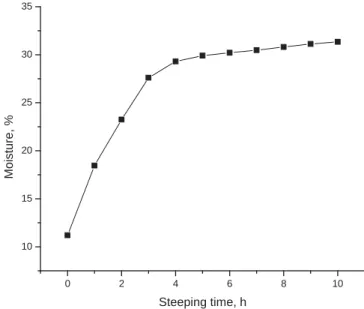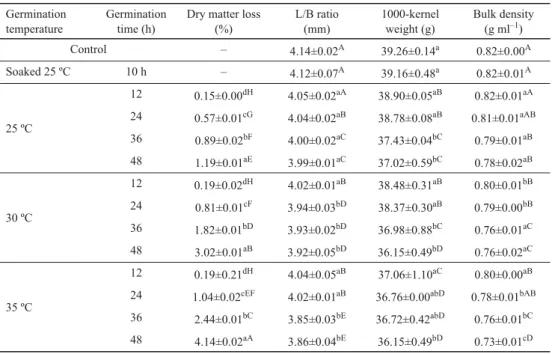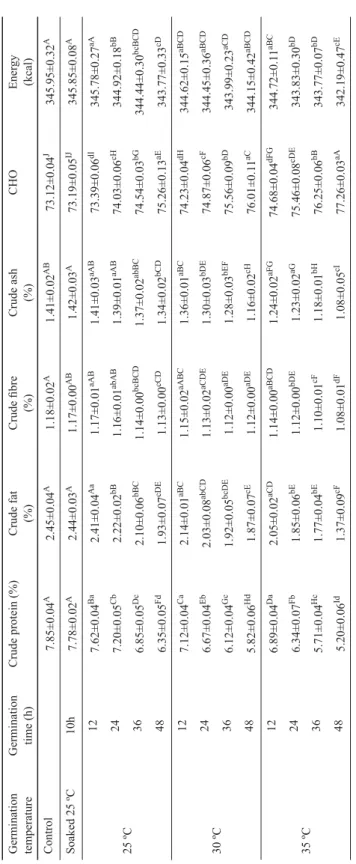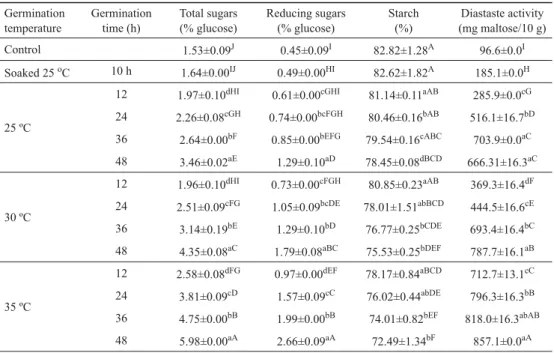DOI: 10.1556/066.2018.47.1.9
GERMINATION BEHAVIOUR, PHYSICO-NUTRITIONAL PROPERTIES, AND DIASTASE ACTIVITY OF BROWN RICE INFLUENCED BY GERMINATION TIME AND TEMPERATURE
A. SINGH*, S. SHARMA and B. SINGH
Department of Food Science and Technology, Collage of Agriculture, Punjab Agricultural University, Ferozpur Road, Ludhiana, Punjab, 141004. India
(Received: 19 March 2017; accepted: 4 June 2017)
Germinated brown rice received great attention as healthy ingredient and can be used as an alternative source in the malting and brewing industry. The germination capacity, physico-nutritional properties, sugars, and diastase enzyme activity of brown rice affected by germination times and temperature were determined and compared with control.
Soaking in water increased the moisture content of brown rice. Germination rate of brown rice was also increased by higher germination time and temperature and reached maximum after 48 h of germination at 35 ºC. However, dry matter loss, grain weight, and density are affected to a lesser extent. Germination signifi cantly (P<0.05) affects the crude protein, fat, fi bre, and ash contents. Total carbohydrates content showed linear relationship with germination time and temperature. During germination, hydrolytic enzymes act on starch, reducing its concentration and resulting in higher total and reducing sugars amounts. Increase in germination time and temperature also increased diastase enzyme activity.
Keywords: brown rice, germination, nutritional properties, sugars, diastase enzyme activity
Rice (Oryza sativa) known as ‘Queen of cereals’ is a staple food consumed by 50% of the population in the world, particularly in the Asians countries. Brown rice contains 5–7% bran, 2–3% embryo, and the 90–92% endosperm is excellent source of proteins, dietary fi bre, vitamins, minerals, organic acids, and health promoting bioactive components, better than milled rice (MOHAN et al., 2010).
In recent times, germinated brown rice (GBR) has been distinguished as one of the novel ingredients and gained a great attention, especially in rice-dependent economies (MOONGNGARM & SAETUNG, 2010). Time and temperature are the main factors affecting germination of brown rice, and both parameters, i.e. germination time and temperature, play important roles in sugar development during the process of germination (SAMAN et al., 2008).
Studies reported that the majority of processes take place during the fi rst 48 h of germination, increasing with the increase in temperature (27–37 ºC), while the rate of germination drops sharply at lower temperatures (SAMAN et al., 2008). During the process of germination, various biochemical activities produce essential compounds and energy for the formation of the seedling, which drastically changes the physico and biochemical compositions of brown rice. Consequently, the overall nutritional quality improves (HU et al., 2017). Germinated rice grains were not frequently used in breweries as they essentially produce α-amylase during the process. Hence, GBR possesses great potential that could be utilized for malt and as a natural source of hydrolytic enzyme in sugar and brewing industries (AYERNOR & OCLOO, 2007). The objective of the present study was, therefore, to investigate germination behaviour and compositional changes in brown rice related to germination time and temperature.
1. Materials and methods
Paddy (PR 123) (12.8% m.c) was procured from Punjab Agricultural University, Ludhiana, and husk was removed in a rubber roll Sheller (Stake Rice Mill, Japan) to get brown rice.
1.1. Germination of brown rice
Brown rice was steeped in excess distilled water at 25 ºC for 10 h, and then placed in a thin layer on wet muslin cloth on tray and covered with another layer of wet muslin cloth. Grains were allowed to germinate for 12, 24, 36, and 48 h at temperature of 25, 30, and 35 ºC, in an incubator (85% relative humidity) (M/s. Narang Scientifi c Works, New Delhi), followed by drying in tray drier at 45±2 ºC, and stored in jars at refrigeration temperature (4–7 ºC) for subsequent analysis. Non-germinated brown rice was served as the control.
1.2. Steeping behaviour of brown rice
Percent increase in the moisture content as per standard AACC (2000) was estimated at different soaking time intervals at 25 ºC to assess the soaking behaviour of brown rice.
1.3. Germination characteristics of brown rice
Briefl y, a selected number (50) of grains were allowed to germinate at variable germination conditions and the numbers of totally germinated grains were counted every 12 h.
1.4. Dry matter loss
The weights in gram of non-germinated and germinated brown rice (after drying and removing plumule and radicle) were recorded (AYERNOR & OCLOO, 2007). Loss in weight refl ects dry matter loss (%).
1.5. Physical properties of brown rice
1.5.1. Thousand-kernel weight. A sensitive electronic balance was used to calculate the thousand-kernel weight of GBR grains.
1.5.2. L/B ratio. The length and breadth of randomly selected un-germinated and germinated brown rice kernels were measured using laboratory scale Vanier calliper.
1.5.3. Bulk density. Ten grams of the samples were placed in a graduated cylinder (25 ml) and packed by gentle tapping of the cylinder on a bench top, ten times. The fi nal volume of the sample was measured and expressed as g ml–l.
1.6. Proximate composition
The proximate composition (protein, fat, fi bre, and ash) of the brown rice samples were analysed at 14% moisture using the standard procedures of AACC (2000). Total carbohydrate content was calculated by difference. The energy value (kcal/100 g) of the samples was determined as: (4×protein)+(9×fat)+(4×carbohydrate).
1.7. Total starch
Starch present in the given sample was converted to sugars by acid hydrolysis and the amounts of sugars were estimated by determining the volume of unknown sugar solution required to completely reduce a measured volume of Fehling’s solution to red insoluble cuprous oxide (AACC, 2000).
1.8. Total sugars and reducing sugars
Sugars (total and reducing) present in the samples were measured by the amount of ferricyanide reduced by sugar extracts under favourable conditions as per standard AACC (2000) method.
1.9. Diastases enzyme activity
Diastase activity in the fl our was determined under standard reaction conditions. The enzyme was extracted with buffer solution at 40 ºC, reacted with alkaline ferricyanide, and the amount of reducing sugars thus formed by amylolytic enzyme action was then estimated by the standard AACC (2000) method.
1.10. Statistical analysis
All experimental results were triplicates. Mean values were compared using analysis of the variance (ANOVA) test, and Tukey’s posthoc test at P<0.05 was applied in order to establish signifi cant differences between germination conditions (SPSS version 16.0)
2. Results and discussion
2.1. Steeping characteristics of brown rice
The moisture content of brown rice, which had been steeped for different time periods at 25 ºC, is shown in Figure 1. Steeping includes the commencement of cell elongation, respiration, embryo’s secretary activity, and enzyme activation. Water provided must be enough during steeping to allow good germination, but not at extremely levels, as grains will show a reduction in germination vigour when exposed to an excess of water (SAMAN et al., 2008). Moisture uptake during the early stage of soaking for the fi rst 4 h was very rapid, slowed down subsequently, and then reached a plateau (10 h). After a signifi cant time interval of steeping, moisture content increased 3-fold (11.23 to 31.2%), due to endosperm micropores that took up water by capillary action resulting in rapid hydration (MIAH et al., 2002).
0 2 4 6 8 10 10
15 20 25 30 35
Moisture, %
Steeping time, h
Fig. 1. Steeping characteristics of brown rice
2.2. Germination capacity of brown rice
Germination capacity of brown rice intensifi ed signifi cantly (P<0.05) with increased germination time and temperature (Fig. 2). The mean percent germination capacity of brown rice after 12 h of germination is 68.17, which increased signifi cantly (P<0.05) to 73.38, 81.06, and 87.85% after 24, 36, and 48 h of germination, respectively. The germination capacity of brown rice also increased as the temperature of germination increased. Similar results for increase in germination capacity of brown rice with increase in germination time and temperature were also reported by CACERES and co-workers (2014). Temperature at which grains are germinated is one of the key features that affect germination capacity and it also plays a critical role in sugars development (SAMAN et al., 2008).
2.3. Dry matter loss
Dry matter loss or vegetative loss, the material lost in converting grain into malt, increased signifi cantly with increase in germination time and temperature (Table 1). As the germination duration increased from 12 to 48 h and temperature from 25 to 35 °C, the mean % dry matter loss increased from 0.18 to 2.78% and 0.70 to 1.95%, respectively. Germination of brown rice for 48 h at 25, 30, and 35 °C increased the % dry matter loss to 1.9%, 3.02%, and 4.14%, respectively. The increase in dry matter loss of grains during steeping could be due to leaching out of solids, increased metabolic activity in grains, removal of root and shoot (vegetative growth), and chemical changes occurring during germination (AYERNOR and OCLOO, 2007).
0 10 20 30 40 50 60 70 80 90 100
12 h 24 h 36 h 48 h 12 h 24 h 36 h 48 h 12 h 24 h 36 h 48 h
Germination capacity, %
25 ºC 30 ºC 35 ºC Germination conditions
Fig. 2. Germination capacity of brown rice as affected by germination time and temperature
Table 1. Effect of germination conditions on dry matter loss and physical properties of germinated brown rice Germination
temperature
Germination time (h)
Dry matter loss (%)
L/B ratio (mm)
1000-kernel weight (g)
Bulk density (g ml–1)
Control – 4.14±0.02A 39.26±0.14a 0.82±0.00A
Soaked 25 ºC 10 h – 4.12±0.07A 39.16±0.48a 0.82±0.01A
25 ºC
12 0.15±0.00dH 4.05±0.02aA 38.90±0.05aB 0.82±0.01aA 24 0.57±0.01cG 4.04±0.02aB 38.78±0.08aB 0.81±0.01aAB 36 0.89±0.02bF 4.00±0.02aC 37.43±0.04bC 0.79±0.01aB 48 1.19±0.01aE 3.99±0.01aC 37.02±0.59bC 0.78±0.02aB
30 ºC
12 0.19±0.02dH 4.02±0.01aB 38.48±0.31aB 0.80±0.01bB 24 0.81±0.01cF 3.94±0.03bD 38.37±0.30aB 0.79±0.00bB 36 1.82±0.01bD 3.93±0.02bD 36.98±0.88bC 0.76±0.01aC 48 3.02±0.01aB 3.92±0.05bD 36.15±0.49bD 0.76±0.02aC
35 ºC
12 0.19±0.21dH 4.04±0.05aB 37.06±1.10aC 0.80±0.00aB 24 1.04±0.02cEF 4.02±0.01aB 36.76±0.00abD 0.78±0.01bAB 36 2.44±0.01bC 3.85±0.03bE 36.72±0.42abD 0.76±0.01bC 48 4.14±0.02aA 3.86±0.04bE 36.15±0.49bD 0.73±0.01cD Values represent mean (n=3) ± standard deviation. Means having different superscripts from A, B, C to J differ signifi cantly (P<0.05) column-wise among different treatments. Means having different superscripts a, b, c, and d show signifi cant (P<0.05) differences during different germination time at each temperature.
2.4. Physical properties of germinated brown rice
2.4.1. L/B ratio. Germination conditions have a non-signifi cant effect on the length/breadth ratio (L/B ratio) of brown rice (Table 1). L/B ratio of non-germinated brown rice was 4.14,
enlarge, while upon drying, due to substantial loss of moisture, the kernel again shrinks back to smaller size leading to the reduction in L/B ratio.
2.4.2. Thousand-kernel weight. Thousand-kernel weight indicates density and kernel size of the food commodity. Substantial changes in the 1000 grains weight of brown rice grains were observed after germination at different times and temperatures (Table 1). Non- germinated brown rice had a 1000-kernel weight of 39.26 g, which was reduced by 5.70 and 7.92% after 48 h of germination at 25 and 35 °C, respectively. Results in the present study were in accordance with fi ndings of AYERNOR and OCLOO (2007).
2.4.3. Bulk density. Non-germinated brown rice had the highest bulk density (0.82 g ml–1), though germination brought only non-signifi cant decrease in bulk density of grains (Table 1). Bulk density of brown rice germinated under different time and temperature conditions varied from 0.82–0.73 g ml–1. During germination process, grain constituents were lost or utilized as food reserves for energy and growth of the new seedling, which, thus, decreased the bulk density of grain (AYERNOR & OCLOO, 2007). QUADIR and co-workers (2012) also reported 6.06–15.41% decrease in the bulk density for 3 paddy cultivars after germination.
2.5. Proximate composition of germinated brown rice
The nutritional composition of brown rice non-germinated and germinated under varying time and temperature conditions in this study are shown in Table 2. Germination had inverse effect on the protein content of the grain. With extended time and increased temperature of germination, the protein content of brown rice decreased signifi cantly (P<0.05) (Table 2).
After 48 h of germination at 25, 30, and 35 °C, protein content of brown rice was reduced by 5.20, 5.82, and 6.35%, respectively. KIM and co-workers (2012) also reported that germination caused decrease in protein contents in different rice cultivars, due to loss of nitrogenous compounds during soaking and increased protease activity during germination. In contrast, studies of MOONGNGARM and SAETUNG (2010), however, reported increase in the protein content of germinated rice, due to net synthesis of enzyme proteins. Fat content was observed to be noticeably higher in non-germinated brown rice (2.45%) but it decreased signifi cantly (P<0.05) with increase in germination time and temperature by 1.37% to 2.41% (Table 2).
The decrease in fat content at different germination conditions ranged from 21.22 to 44.08%, and it decreased as a result of the increased lipolytic enzymes activities, which hydrolyse fat components into fatty acids and glycerol during germination (CHINMA et al., 2009). Similar results of reduction of fat content were also reported by MOHAN and co-workers (2010). Non- germinated brown rice fl our had the highest ash content (1.35%), while brown rice germinated at 35 °C for 48 h had the lowest ash content (1.08%). There was signifi cant (P<0.05) decrease in ash content (4.4 to 46.5%) in germinated brown rice as the germination progressed in time, which was due to loss of minerals as outgrowth of root and shoots were removed after drying.
MOONGNGARM and SAETUNG (2010) also reported decrease in ash content during germination.
Crude fi bre content of brown rice was signifi cantly (P<0.05) infl uenced by germination time and temperature (Table 2). Non-germinated brown rice had crude fi bre content of 1.18%, which after 48 h of germination at 25, 30, and 35 °C, decreased signifi cantly by 4.13, 5.08, and 8.47%, respectively, due to degradation of cell wall of outer bran layer. In contrast, OHTSUBO and co-workers (2005), however, found that crude fi bre content in germinated brown rice increased. Studies of ONGOL and co-workers (2013) are in accordance with the
Table 2. Effect of germination conditions on changes in proximate composition of germinated brown rice Germination time (h)Crude protein (%)Crude fat (%)Crude fi bre (%)Crude ash (%)CHOEnergy (kcal) 7.85±0.04A2.45±0.04A1.18±0.02A1.41±0.02AB73.12±0.04J345.95±0.32A 10h7.78±0.02A2.44±0.03A1.17±0.00AB1.42±0.03A73.19±0.05IJ345.85±0.08A 127.62±0.04Ba2.41±0.04Aa1.17±0.01aAB1.41±0.03aAB73.39±0.06dI345.78±0.27aA 247.20±0.05Cb2.22±0.02bB1.16±0.01abAB1.39±0.01aAB74.03±0.06cH344.92±0.18bB 366.85±0.05Dc2.10±0.06bBC1.14±0.00bcBCD1.37±0.02abBC74.54±0.03bG344.44±0.30bcBCD 486.35±0.05Fd1.93±0.07cDE1.13±0.00cCD1.34±0.02bCD75.26±0.13aE343.77±0.33cD 127.12±0.04Ca2.14±0.01aBC1.15±0.02aABC1.36±0.01aBC74.23±0.04dH344.62±0.15aBCD 246.67±0.04Eb2.03±0.08abCD1.13±0.02aCDE1.30±0.03bDE74.87±0.06cF344.45±0.36aBCD 366.12±0.04Gc1.92±0.05bcDE1.12±0.00aDE1.28±0.03bEF75.56±0.09bD343.99±0.23aCD 485.82±0.06Hd1.87±0.07cE1.12±0.00aDE1.16±0.02cH76.01±0.11aC344.15±0.42aBCD 126.89±0.04Da2.05±0.02aCD1.14±0.00aBCD1.24±0.02aFG74.68±0.04dFG344.72±0.11aBC 246.34±0.07Fb1.85±0.06bE1.12±0.00bDE1.23±0.02aG75.46±0.08cDE343.83±0.30bD 365.71±0.04Hc1.77±0.04bE1.10±0.01cF1.18±0.01bH76.25±0.06bB343.77±0.07bD 485.20±0.06Id1.37±0.09cF1.08±0.01dF1.08±0.05cI77.26±0.03aA342.19±0.47cE ferent superscripts from A, B, C to J differ signifi cantly (P<0.05) column-wise among different treatments. ferent superscripts a, b, c, and d show signifi cant (P<0.05) differences during different germination time at each temperature. CHO: carbohydrates; kcal:
present study. Carbohydrate content of brown rice samples germinated at varying conditions ranged between 73.18% and 77.20% (Table 2). Carbohydrate content increased signifi cantly (P<0.05) in brown rice with proliferation through germination. Non-germinated brown rice was observed to have the highest energy value (364.18 kcal) and brown rice germinated at 35 °C for 48 h had the lowest value (341.93 kcal).
2.6. Total starch
Data on the starch content of brown rice as infl uenced by germination conditions are presented in Table 3. Non-germinated brown rice had 82.82% starch, which decreased signifi cantly (P<0.05) as germination progressed at higher time and temperature values. When brown rice germinated at 25, 30, and 35 °C for 48 h, starch content decreased by 5.28, 8.80, and 12.47%, respectively, due to the increased activity of amylases during germination, which hydrolyse starch to yield 6-carbon sugars (AYERNOR & OCLOO, 2007). Similar results for reduction in starch content of germinated rice and brown rice were also reported by CHUNG and co-workers (2012).
2.7. Total sugars and reducing sugars
Total sugars and reducing sugars contents of brown rice as affected by germination time and temperature are presented in Table 3. Increase in germination time from 12 to 48 h and temperature from 25 to 35 ºC, signifi cantly (P<0.05) increased the accumulation of sugars in brown rice. Total sugars (% glucose) and reducing sugars (% glucose) contents of non- germinated brown rice were 1.53 and 0.45%, respectively. Mean total sugars content after 12 h was 2.17%, which increased by 31.80 and 111.98% after 24 and 48 h of germination, respectively. An increase of 64.44 and 186.67% in reducing sugars contents was observed after 24 and 48 h of germination, respectively. Similar trend was also observed when germination temperature was increased. The pattern of increase and changes in reducing sugars content observed in the present study was similar to those reported in earlier studies by MOONGNGARM and SAETUNG (2010). The increase in total and reducing sugars and non- reducing sugars contents after germination is mostly at the expense of hydrolysis of starch presumably by the initial action of α-amylase enzyme on the molecules of starch (MOHAN et al., 2010).
2.8. Diastase activity
Diastase activity provides a measurement of the saccharifi cation potential of malted grains.
Germination time and temperature have signifi cant (P<0.05) effect on the diastase enzyme activity of brown rice (Table 3). Non-germinated brown rice has diastase activity of 96.64 mg maltose/10 g, which increased signifi cantly (P<0.05) as germination time and temperature increased (Table 3). The mean diastase activity of brown rice after 12 h of germination was 456 mg maltose/10 g, which after 48 of germination increased to 757 mg maltose/10 g. When germination was done at 25 °C, the mean diastase activity was 543 mg maltose/10 g, which increased to 796 mg maltose/10 g at 35 °C. AYERNOR and OCLOO (2007) also reported that diastase activity increased signifi cantly as germination time increased.
Table 3. Effect of germination conditions on contents of sugars and starch and diastase activity of germinated brown rice
Germination temperature
Germination time (h)
Total sugars (% glucose)
Reducing sugars (% glucose)
Starch (%)
Diastaste activity (mg maltose/10 g)
Control 1.53±0.09J 0.45±0.09I 82.82±1.28A 96.6±0.0I
Soaked 25 oC 10 h 1.64±0.00IJ 0.49±0.00HI 82.62±1.82A 185.1±0.0H
25 ºC
12 1.97±0.10dHI 0.61±0.00cGHI 81.14±0.11aAB 285.9±0.0cG 24 2.26±0.08cGH 0.74±0.00bcFGH 80.46±0.16bAB 516.1±16.7bD 36 2.64±0.00bF 0.85±0.00bEFG 79.54±0.16cABC 703.9±0.0aC 48 3.46±0.02aE 1.29±0.10aD 78.45±0.08dBCD 666.31±16.3aC
30 ºC
12 1.96±0.10dHI 0.73±0.00cFGH 80.85±0.23aAB 369.3±16.4dF 24 2.51±0.09cFG 1.05±0.09bcDE 78.01±1.51abBCD 444.5±16.6cE 36 3.14±0.19bE 1.29±0.10bD 76.77±0.25bCDE 693.4±16.4bC 48 4.35±0.08aC 1.79±0.08aBC 75.53±0.25bDEF 787.7±16.1aB
35 ºC
12 2.58±0.08dFG 0.97±0.00dEF 78.17±0.84aBCD 712.7±13.1cC 24 3.81±0.09cD 1.57±0.09cC 76.02±0.44abDE 796.3±16.3bB 36 4.75±0.00bB 1.99±0.00bB 74.01±0.82bEF 818.0±16.3abAB 48 5.98±0.00aA 2.66±0.09aA 72.49±1.34bF 857.1±0.0aA Values represent mean ± standard deviation. Means having different superscripts from A, B, C to J differ signifi cantly (P<0.05) column-wise among different treatments. Means having different superscripts a, b, c, and d show signifi cant (P<0.05) differences during different germination time at each temperature.
3. Conclusions
From the present study it can be concluded that longer steeping time increased the moisture content of brown rice. Germination capacity and dry matter loss of brown rice increased as germination time and temperature increased, while L/B ratio and bulk density decreased.
Increase in germination time and temperature had inverse effect on the nutritional composition of germinated brown rice. Production of sugars increased during germination with reduction in starch content, and maximum sugar content was observed after 48 h of germination at 35 °C. Enzymatic activity also increased and reached its peak after 48 h of germination at a temperature of 35 °C.
References
AACC (2000): Approved methods of American Association of Cereal Chemists. 10th ed. The Association, St. Paul, MN.
AYERNOR, G.S. & OCLOO, F.C.K. (2007): Physico-chemical changes and diastatic activity associated with germinating paddy rice (PSB.Rc 34). Afr. J. Food Sci., 1, 37–41.
CACERES, P.J., MARTINEZ-VILLALUENGA, C., AMIGO, L. & FRIAS, J. (2014): Maximising the phytochemical content and antioxidant activity of Ecuadorian brown rice sprouts through optimal germination conditions. Food Chem., 152, 407–414.
CHINMA, C.E., ADEWUYI, O. & ABU, J.O. (2009): Effect of germination on the chemical, functional and pasting properties of fl our from brown and yellow varieties of tigernut (Cyperus esculentus). Food Res. Int., 42, 1004–1009.
CHUNG, H.J., CHO, D.W., PARK, J.D., KWEON, D.K. & LIM, S.T. (2012): In vitro starch digestibility and pasting properties of germinated brown rice after hydrothermal treatments. J. Cereal Sci., 56, 451–456.
HU, Z., TANG, X., LIU, J., ZHU, Z. & SAHO, Y. (2017): Effect of parboiling on phytochemical content, antioxidant activity and physicochemical properties of germinated red rice. Food Chem., 214, 285–292.
KIM, H.Y., HWANG, I.G., KIM, T.M., WOO, K.S., PARK, D.S., KIM, J.H., KIM, D.J., LEE, J., LEE, Y.R. & JEONG, H.S.
(2012): Chemical and functional components in different parts of rough rice (Oryza sativa L.) before and after germination. Food Chem., 134, 288–293.
MIAH, M.A.K., HAQUE, A., DOUGLASS, M.P. & CLARKE, B. (2002): Parboiling of rice. II. Effect of hot soaking time on the degree of starch gelatinization. Int. J. Food Sci. Tech., 37, 539–545.
MOHAN, B.H., MALLESHI, N.G. & KOSEKI, T. (2010): Physico-chemical characteristics and non-starch polysaccharide contents of Indica and Japonica brown rice and their malts. LWT – Food Sci. Technol., 43, 784–791.
MOONGNGARM, A. & SAETUNG, N. (2010): Comparison of chemical compositions and bioactive compounds of germinated rough rice and brown rice. Food Chem., 122, 782–788.
OHTSUBO, K.I., SUZUKI, K., YASUI, Y. & KASUMI, T. (2005): Bio-functional components in the processed pre- germinated brown rice by a twin-screw extruder. J. Food Comp. Anal., 18, 303–316.
ONGOL, M.P., NIYONZIMA, E., GISANURA, I. & VASANTHAKAALAM, H. (2013): Effect of germination and fermentation on nutrients in maize fl our. Pak. J. Food Sci., 23, 183–188.
QUADIR, N., WANI, S.A., BHAT, B.A., WANI, T.A. & QURAAZAH, A. (2012): Germination behavior of some Kashmiri paddy cultivars. J. Chem. Biol. Phys. Sci., 2, 1820–1829.
SAMAN, P., VAZQUEZ, J.A. & PANDIELLA, S.S. (2008): Controlled germination to enhance the functional properties of rice. Process Biochem., 43, 1377–1382.



